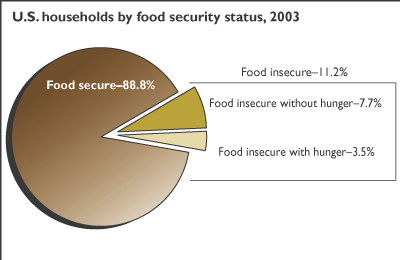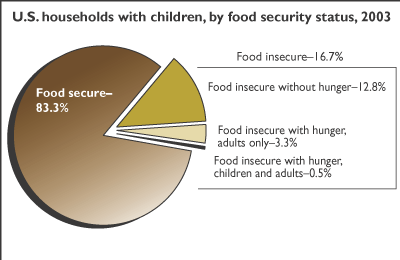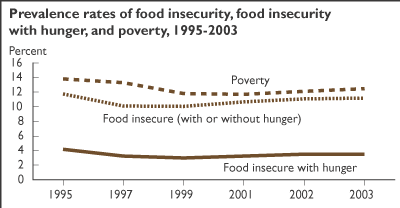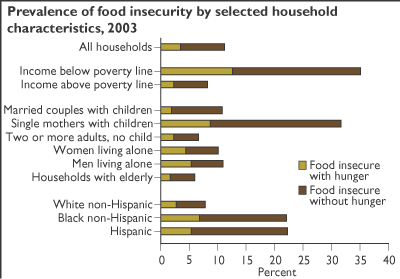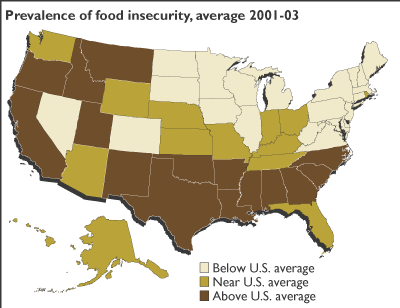Data Feature
- by Mark Nord
- 4/1/2005
Measuring U.S. Household Food Security
USDA monitors the food security of the Nation's households through an annual, nationally representative household survey. Food security for a household means that all household members have access at all times to enough food for an active, healthy life. Food security is a foundation for a healthy, well-nourished population.
The food security survey is conducted annually by the U.S. Census Bureau as a supplement to its monthly Current Population Survey—the same survey that provides data for the Nation's monthly unemployment statistics and annual poverty rates. About 50,000 surveyed households respond to a series of questions about food expenditures, use of Federal and community food assistance programs, and behaviors and experiences known to characterize households having difficulty meeting their food needs.
Households are classified as food secure, food insecure without hunger, or food insecure with hunger based on the number of food-insecure conditions reported. Households are classified as food insecure with hunger if their reported food-insecure conditions suggest that one or more household members was hungry at some time during the year because the household could not afford enough food. Households with children are further classified by whether any children were hungry at any time during the year because of the household's lack of money and other resources for food.
The annual food security survey data are the basis for an ERS series of reports. The data are also used in researching the causes of food insecurity and the role of USDA's food assistance programs in improving food security. The survey data (with all identifying information deleted to protect confidentiality) are made available to other researchers as public-use files to facilitate research on U.S. households' food security.
Nearly 90 percent of U.S. households were food secure throughout the entire year in 2003. About 11 percent of households had difficulty at some time during the year providing enough food for all their members due to a lack of money and other resources. Most food-insecure households obtained enough food to avoid hunger, using a variety of coping strategies, such as eating less varied diets, participating in Federal food assistance programs, or getting emergency food from community food pantries or emergency kitchens. But 3.5 percent of U.S. households were food insecure to the extent that one or more household members was hungry, at least some time during the year, because the household could not afford enough food.
In U.S. households, children—especially younger children—are usually protected from substantial reductions in food intake and ensuing hunger unless hunger among adults reaches quite severe levels. In 2003, only one-half of 1 percent of households with children were so severely food insecure that any of the children was ever hungry during the year. A substantially larger proportion (3.8 percent) had adult members who were hungry at times during the year because of their households' food insecurity.
One of the Nation's health objectives, expressed in the U.S. Department of Health and Human Services' Healthy People 2010 plan, is to reduce the prevalence of food insecurity to 6 percent, half of its 1995 level, by the year 2010. Food security in the U.S. improved from 1995, when it was first measured, through the late 1990s. Some of these gains were eroded following the 2001 recession. The prevalence of food insecurity differed from the poverty rate by only a few percentage points in each year since 1995. The similarity in levels of the two measures is consistent with the original concept of the poverty line—an income level at which households could just meet their basic needs for food and other essentials.
Food insecurity is strongly associated with household income. It is, by definition, a condition that arises from a lack of enough income and other resources for food. Thirty-five percent of poor households had difficulty putting enough food on the table at times during the year compared with 8 percent of households with incomes above the poverty line. Single mothers with children were especially vulnerable to food insecurity, as were Black and Hispanic households. Households with two or more adults but no children were more food secure than the national average as were households with elderly members.
The prevalence of food insecurity was higher than the national average in 15 States and lower than the national average in 21 States and the District of Columbia. In the remaining 14 States, differences from the national average were small and not statistically significant. Research by ERS and others has shown that States with higher rates of food insecurity generally have the following characteristics:
- Higher than average poverty rate
- Higher than average unemployment rate or seasonally high unemployment
- High costs of housing and utilities relative to income
- High rate of residential mobility (a measure of how frequently people move)
- High proportion of the population under age 18
This article is drawn from:
- Nord, M., Andrews, M. & Carlson, S. (2004). Household Food Security in the United States, 2003. U.S. Department of Agriculture, Economic Research Service. FANRR-42.
You may also like:
- Food Security in the U.S.. (n.d.). U.S. Department of Agriculture, Economic Research Service.


